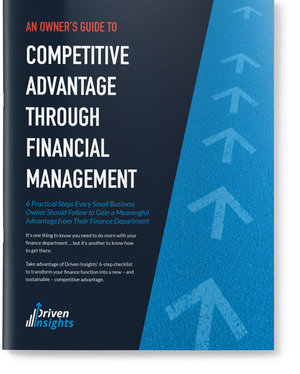You're in good company if you're being pulled in countless directions as you work to grow your firm. Keeping all those balls in the air is tricky and tiring. Prioritization is a constant battle.
Most owners focus their energy and best people on closing new business and delivering on recent deals. But are those owners providing the right guidance? And what priorities aren't getting adequate attention? The fact is most small business owners are pouring money down the drain by not being able to answer these questions.

To identify where you're leaving real money on the table, let's look at each phase of the customer life cycle as well as the critical challenges on the road to success.
2 TIPS: You're likely already aware of each of these items, but are you aware that adding financial management as a top ongoing priority will address them all? And I'd challenge you to think deeply about #9.
1. Marketing
Naturally, you need to generate awareness of your services in your target marketing order to grow. Getting the word out costs money. And you typically must build a marketing mix with a diverse set of campaigns. Some campaigns work well in surfacing qualified leads, some less so and others you simply don't know. But unless you're tracking your return on marketing dollars, you won't know which activities warrant further investment and which should tweaked or shelved. Continuing to hope for the best without the data to inform your marketing decisions is the first example of how you might be pouring money down the drain.
2. Sales
Sales is about closing new business, but successful business owners monitor their sales spend in parallel with their pipeline. What good is it to earn business that doesn't earn you a profit. Tracking customer acquisition cost ("CAC") helps you align your sales approach with your revenue stream, ensuring adequate profitability and cash flow. In the software-as-a-service ("SaaS") world, thanks to David Skok, CAC gets the attention it deserves - known as a "startup killer", but other industries need to follow the SaaS example.
3. Fulfilling Orders
Once a lead becomes a customer, your firm incurs real cost fulfilling the obligations of your sales contract. It starts with onboarding and continues for the life of the customers. Visibility into your firm's profitability by service offering and even by customer is incredibly powerful. Learning which services and which customers are the most (and least) profitable is game changing. Use that information to not only adapt your pricing, but also develop an ideal customer profile to focus your sales and marketing efforts and your cash flow will grow markedly.
4. Investing in Growth
Options abound in terms of where an owner might invest in growth and the relative impact of those investments is anything but certain. Whether its when to hire that next employee or whether you'll be able afford the technology that promises to streamline operations, these growth decisions are difficult. But running outcome scenarios based on key assumptions can help an owner make informed decisions, manage risk and increase probability of success.
5. Raising Money
Growth costs money and many business owners need to raise debt or equity to hit their goals. Owners must navigate a sea of capital sources and craft a persuasive financial story to secure the funds. When a capital provider asks for your financials, you'd better be prepared. Tightly managing your financials and closing the books each month will ensure you always have the financial and operating metrics you'll need to showcase the health of your business. That reporting could be the difference between raising the capital or not. And it will also provide leverage when negotiating terms.
6. Managing Your Team
Central to an an organization's success is the owner's ability to keep their team motivated and focused on the firm's most important goals. One of the most effective tools in an owner's quiver is the annual budget. A budget quantifies revenue and expense objectives for the year and when used effectively it rallies a team to do their part in acheiving them. Left without a common goal, a team wanders and results falter.
7. Competing
Competing and winning in business requires self awareness and ongoing adaptation to market dynamics. Out maneuvering your competition in business requires an understanding of how your performance stacks up. Compare your financial results to those of your peers and you'll quickly see opportunity for improvement in areas where you lag other market players. Likewise, you'll identify areas of relative strength you'll want to leverage.
8. Exiting
As a business owner, you've undoubtedly seen many articles and books on how to maximize the value of your firm at exit. A lot goes into the successful sale of a firm, but it always requires putting yourself in the shoes of potential buyers. What financial metrics do they weight over others? Are there certain value drivers unique to your industry? To ensure you are building the type of value the market will ultimately reward, you need to answer these questions and manage toward peforming optimally on the measures. To do otherwise, is leaving your ultimate success to chance.
9. Focus
Saved my personal favorite (and the subject of a separate article) - small business focus - for last. If there's one thing I learned from my experience acting in the context of a private equity investor earlier in my career, it's that the firms with the highest valuations, biggest profit margins and greatest levels of customer and employee satisfaction all share one attribute. They all have focus. Successful small business owners focus on market niches where they can be most efficient. Of equal importance, they pass on opportunities that are outside that sweet spot. This focus translates into shorter sales cycles, lower fulfillment costs/timelines and stickier customers. What's your focus?
Leakage will Persist until you reprioritize
Profitable growth doesn't just happen without thoughtful planning and careful adjustments. To enhance your firm's growth potential and its ultimate value, you must ensure you're focused on the right priorities and providing your team with better guidance. To do so, you must embrace the financial management of your firm as a top priority.
We get it. There's not enough time in the day to pursue all the opportunities in your sales pipeline, let alone keep a watchful eye on each of the areas listed in this article. We also appreciate that most bookkeepers aren't trained to produce these types of insights. And you may not be in a position to hire a CFO - with first-hand experience with the nuances of your industry - to invest the time needed to package the requisite reporting each month. So where do you turn?
How to COST-EFFECTIVELY MAKE FINANCIAL MANAGEMENT AN ONGOING PRIORITY
Like the concept of taking financial control of your firm, but not certain you can pull it off? Consider outsourcing your finance department to Driven Insights. We specialize in producing ongoing game-changing, CFO-level insights in a grab-and-go dashboard format that allows you to take advantage of the information while focusing where you add the most value.
Our clients all benefit from timely, accurate insights that inform their decision making. Reach out if you'd like to see if Driven Insights is right for you: info@driveninsights.com, 888-631-1124.








